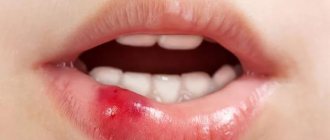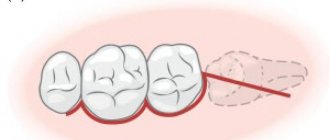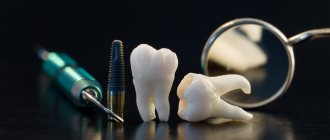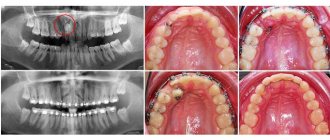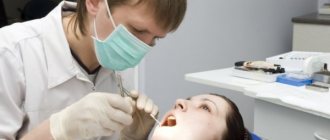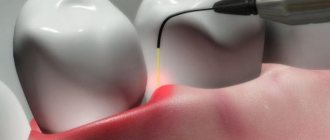What is a cyst on the gum, in what cases does it appear and how to treat the problem
Many dental diseases develop asymptomatically in the early stages, and this is where their main danger lies. One of such pathologies is a cyst - the neoplasm grows gradually, and at first it may not cause any concern at all. Therefore, patients often seek help when a fully formed abscess on the mucous membrane creates severe discomfort and provokes severe pain. A cyst on the gum is a painful lump filled with purulent exudate. Today we’ll talk about what to do when faced with a similar problem and how to treat the pathology.
Why does a cyst appear on the gum?
Treat or remove?
There are two main methods for treating a cyst on the root of a tooth - therapeutic (conservative) and surgical (operative). If the cyst was detected in a timely manner, at an early stage of the disease, the doctor may prescribe conservative treatment . It is indicated in cases where the diameter does not exceed 8 millimeters . In this case, the doctor fills the cyst cavity with a special cement filler. Antibiotics are prescribed as an auxiliary treatment to prevent the occurrence and spread of the inflammatory process. Self-therapy with antibiotics is not used, since there is no such drug that can be taken to get rid of the cyst.
The surgical method of treatment is much more often used . Since the formation of a cyst is asymptomatic, it is very rarely possible to diagnose the disease at an early stage, when it is still fashionable to cure it without surgery. If it has reached a fairly large size (a centimeter or more), it must be removed.
If previously the removal of a cyst occurred only after the removal of the tooth itself, today there are ways to save the tooth. The removal operation is necessarily carried out under local anesthesia; the patient will not feel pain. In particularly difficult cases, the doctor may resort to removing the cyst along with the diseased tooth. But it should be remembered that tooth extraction is not necessary in all cases without exception.
After the cyst has been removed, the doctor prescribes antibiotics, anti-inflammatory tablets, and rinses. They help prevent unwanted complications from occurring.
Read also: Wisdom tooth coming through, gum pain
Cyst on the gum - what is it and why does it occur?
Before we move on to considering the main reasons for the formation of a dental cyst and a painful formation on the gum, let’s find out what it is and what this phenomenon looks like. In fact, this is one of the forms of periostitis (inflammation of the periosteum), the appearance of which is accompanied by the development of a local infectious-inflammatory process, which, in turn, is concentrated at the apex of the root. As a result, a cavity is formed, the internal space of which is filled with purulent exudate.
On a note! A purulent formation, as if separated by a capsule from the surrounding tissues, is an abscess. Therefore, in many sources, a cyst on the root of a tooth is called a periodontal abscess. This term emphasizes that pathological processes involve periodontal tissue surrounding the root.
The cyst gradually increases in size and, in the absence of appropriate medical intervention, can lead to very unpleasant consequences, including tooth destruction. In a child, such a neoplasm can be caused by poor-quality, untimely treatment of childhood caries and pulpitis or jaw injury, which is especially typical for children who play sports. Among the most common reasons for the appearance of cysts on the gums in adults are the following:
- advanced stage of caries or pulpitis: it is these pathological conditions that most often lead to the appearance of cysts on the gums in both children and adults. In fact, purulent inflammation becomes a complication of the disease. Forming at the root apex, the exudate gradually makes its way to the gingival tissue outward, forming a painful lump on the gum,
The photo shows tooth pulpitis - incompletely sealed canals: during this particular procedure, dentists often make mistakes that lead to the development of such complications. Often, the dentist fails to completely fill the canal, as a result of which a cavity is formed at the apex of the root, and inflammatory processes begin to develop in it,
- accidental perforation of a tooth: during dental treatment, specialists sometimes make another significant mistake - when treating a canal, they inadvertently make a hole in it. Typically, such a problem arises if the doctor incorrectly fixed the pin or completely carried out treatment without an x-ray, essentially blindly. As a result, perforation does not allow complete filling of the canal, since liquid enters there. The result is inflammation and the formation of a periodontal abscess, which then develops into a cystic formation on the gum1.
On a note! Against the background of periodontitis, a so-called periodontal abscess often forms. The disease itself involves the formation of deep periodontal pockets in which purulent masses accumulate. If their outflow is disrupted, ideal conditions are created for the occurrence of an abscess.
Sometimes a cyst becomes a complication of sinusitis, but such cases are quite rare. It should also be noted that if pathology develops during pregnancy, the expectant mother should urgently see a doctor.
Treatment methods for dental cysts
There are different methods of treating this disease; they are used depending on the degree of damage to the tooth by the cyst. Thus, a therapeutic method, laser treatment, treatment with folk remedies and cyst removal can be used. Let's look at each method in detail.
Therapeutic treatment of dental cysts
This method involves treating the tooth with an antiseptic, cleaning and filling . It is effective in such cases as:
absence of fillings on the root canals that prevent access to the cyst;
poorly sealed root canal;
The diameter of the cyst is no more than 8 mm.
The doctor must have access to the cyst using a root canal. First, he disinfects using special means, then pumps out the pus and fills the cavity with paste to form new bone tissue. Next, the root canal is filled and the crown is covered with a filling.
The danger of this type of treatment is frequent relapses, so after the procedure you need to periodically visit the doctor for examination.
Laser treatment
The laser method of treating the formation is the most painless; also, due to laser removal of the cyst, complications practically do not arise.
This type of treatment includes the following stages:
- opening of the tooth and expansion of the canals;
- laser introduction;
- disinfection, inflammation and removal.
The benefits of such treatment and removal are obvious, but there is also a downside. First of all, this is the high cost of laser treatment, as well as the lack of equipment in most clinics, as well as the need to remove the formation.
In addition, after the procedure you should not drink or eat for four hours, which can cause a number of inconveniences.
Surgical method of treatment
The formation is removed surgically in the following cases:
- if there is a pin in the root canal;
- if there is a crown;
- if the cyst is more than 8 mm in diameter;
- with swelling of the gums.
The cyst is removed under local anesthesia; in some cases, the adjacent tooth may also be removed, for example, if its roots have grown into it, or if it is completely destroyed.
After removal, it is forbidden to apply a warming compress so that harmful microbes cannot multiply and you do not get an infection. Also, after removal, you should not take aspirin for pain relief, so as not to provoke bleeding.
Improvement is usually observed half a day after removal; if the condition does not improve, then consult your doctor again.
Treatment of dental cysts with folk remedies
Naturally, folk remedies cannot be the key to treatment, but they can be used in the presence of the first symptoms of the disease or for the purpose of its prevention.
The most common folk method of treating this disease is rinsing with herbs such as calendula, yarrow, chamomile, sage and others. Herbs help relieve acute pain and disinfect the oral cavity. The decoction should be taken only in concentrated form at the rate of 2 tablespoons of herb per cup of boiled water.
An excellent remedy for relieving inflammation is warm salt water . You need to rinse your mouth with it for two minutes in order to penetrate the solution into the blood. You can also brew herbs in salt water to enhance the effect.
To reduce the number of harmful bacteria, take sesame oil. It can be taken in pure form or combined with a hydrogen peroxide solution.
Read also: Swollen gums
Among the most popular folk remedies used to treat this disease is garlic. It is cut or grated and then applied to the cyst to kill germs.
Myrrh essential oil , which is consumed in the form of a tincture, is also considered an effective remedy To prepare it, you should dilute about twenty drops of oil in a glass of water, and then rinse your mouth with this tincture for thirty seconds several times a day.
Often, folk treatment includes the use of alcohol tinctures. In particular, they can be used to disinfect the oral cavity and relieve pain. You can also infuse medicinal herbs with alcohol, for example, make horseradish, as well as a tincture based on calendula, ficus or aloe.
To relieve pain after removal surgery, chew a Kalanchoe leaf , retaining the juice secreted by the plant in your mouth, so the wound will heal faster after removal.
Varieties and localization
Dental experts distinguish several types of cysts. The classification presented below is based on the localization of tumors:
- paradental - usually appears when difficulties arise during the growth of figure eights and during their inflammation,
- follicular – most often occurs when the rudiments of impacted teeth are infected,
- radicular – localized on the root as a consequence of the chronic form of periodontitis,
- primary – formed from dental tissues due to deviations in the development of the rudiment,
- residual – grows in the thickness of the bone after tooth extraction.
Separately, one can distinguish such a form of purulent neoplasm as an eruption cyst. More often than in infants, a similar phenomenon is diagnosed in children 7-10 years old, that is, during the period of change in the primary occlusion.
On a note! Today, teeth with cysts formed on the roots are successfully preserved, and the chance of salvation is higher the more modern technologies the doctor uses in his work. For example, in clinics where they perform manipulations under a microscope, such teeth are treated with high quality, after which they live for many more years, and there is no need to re-treat them. Under a microscope, the cyst is removed carefully and without leaving any residue, leaving healthy tissue unaffected. Using the device, a specialist fills root canals with high precision and also performs beautiful restorations.
Symptoms
In most cases, the development of a cyst occurs without pronounced symptoms .
At first, the gums swell a little, but there is no pain, so a person usually does not attach importance to such changes. As a rule, a cyst is discovered during a regular dental examination. Sometimes patients feel discomfort and pain while chewing. Other symptoms are also possible, namely headache, fatigue and slight fever. With the subsequent formation of flux, swelling of the jaw occurs and facial asymmetry appears.
The presence of the mentioned signs depends on certain characteristics of the body, so to confirm the diagnosis it is necessary to take an x-ray.
Cyst in children
In a child, a gum cyst can form due to caries or poor quality dental treatment. In some cases, cyst formation occurs 2-4 weeks before tooth eruption. So, a small lump with clear liquid forms on the gum. This phenomenon is considered very rare. It does not cause discomfort or pain. The lump goes away on its own over time.
Possible associated symptoms
First, inflammatory processes affect the periodontium. In this case, the person gradually develops characteristic symptoms, and the first thing to worry about is a slight swelling in the area of the causative tooth, as well as minor discomfort while eating. Unfortunately, not everyone seeks dental care at this stage, and the pathology continues to progress. A granuloma forms in the area of edema, which then gradually grows into a cyst.
“My tooth cyst was discovered only when I decided to get braces and took an X-ray. Otherwise, nothing hurt at all, only the sensitivity of the tooth worsened. As a result, I had it removed with a laser. What I mean is that perhaps it makes sense to take a picture before visiting the dentist. Some problems with teeth and gums don’t make themselves felt for a long time, and then boom!”
NinaR., Smolensk, from correspondence on the forum www.32top.ru
The photo shows a swollen cheek.
Often in the initial stages, the process of cyst formation is completely asymptomatic. However, sooner or later severe swelling, soreness and general malaise appear, but it is better, of course, to detect the problem before these symptoms develop. Why is a cyst dangerous? If the situation is neglected, the purulent contents of the cavity will spread beyond its boundaries, which can result in the development of odontogenic periostitis, destructive processes in the jaw bone, osteomyelitis, as well as general intoxication of the body.
What can you do yourself?
Considering only home methods for treating dental cysts without professional help from a dentist in a clinic, you should immediately make a reservation that completely getting rid of this problem is impossible in this way.
Homeopathic and other folk remedies are used in combination with specialized dental techniques as a necessary addition.
Folk remedies can improve the patient’s general condition, significantly alleviate symptoms and speed up recovery. However, home remedies are not used as the main treatment method.
This is especially true for those difficult cases when doctors recommend surgical treatment with removal of the tumor. Or a therapeutic method with the introduction of certain drugs into the root canals for the purpose of cleaning and disinfection, as well as subsequent filling.
It is simply impossible to do this at home. However, if the cyst provokes the formation of a fistula, home auxiliary therapeutic measures cannot be avoided. Most of them help:
- eliminate painful sensations;
- localize and even completely eliminate the resulting inflammation in the tissues ;
- suppress infection;
- effectively disinfect the oral cavity to prevent further development of inflammation.
What are the symptoms of a dental cyst?
Photos and signs of the disease. How to get rid of caries at home in 1 day? Here are some tips.
Herbal infusions
Many plants have medicinal properties that will help fight a cyst formed on the root of a tooth. Among these properties are disinfection of the oral cavity and elimination of infection, pain relief, and relief of inflammation.
Sometimes, with properly selected folk remedies, the cyst even resolves. The main method of using these beneficial properties is to prepare herbal infusions for rinsing.
The most effective in combating this dental problem are:
- sage;
- creeping thyme;
- yarrow;
- chamomile;
- horsetail;
- calendula;
- eucalyptus;
- medicinal hyssop.
The decoction can be prepared quite quickly and easily. The rules apply to all plants used:
To prepare the medicine, pour two full tablespoons of any selected and pre-chopped herb or a mixture of dried plants with boiling water (about a glass).
Then the container is tightly closed, additionally wrapped in a towel or cloth and left to infuse. The decoction is considered ready after complete cooling.
Decoctions can be used in different ways. The most common of them are mouth rinses , as, indeed, for all other home remedies. A variation of this method is baths , when the liquid is simply in the mouth without moving.
You can also use the lotion - moisten cotton wool generously and apply it to the painful area where the cyst and the area of soft tissue inflammation are located.
After just a few days of daily rinsing 4-6 times , the pain is practically not felt, and the inflammation of the soft tissues is significantly reduced.
Decoctions can also be used for indirect, and in this case, general treatment . Since the cause of the cyst is an infection, and after the formation of the cyst it is its source, the body tries to fight it using its own defenses.
This is not always enough. By regularly taking courses of various herbal decoctions, both pure and mixed, you can strengthen your immune system and help your body get rid of the disease on its own.
What does dental caries look like and manifest itself? Photos of stages, treatment, prevention.
This article contains expert recommendations on what to do if a wisdom tooth grows into the cheek.
Every patient should know why a tooth hurts after filling, if the nerve was not removed.
Alcohol infusions
Alcohol is one of the most common antiseptics in medicine (both professional and folk). It is used not only on its own, but also as various tinctures.
The easiest way to use alcohol to improve the condition of a dental cyst is to briefly rinse your mouth with regular vodka or diluted medical alcohol .
This will help reduce pain and help kill infection and bacteria. It is advisable to carry out the procedure several times a day .
Alcohol tinctures of medicinal herbs act somewhat differently. The excellent antiseptic properties of the alcohol itself are enhanced by the healing, bactericidal, anti-inflammatory effects of additional ingredients.
At the same time, the properties of plants also appear more clearly, since alcohol acts as a catalyst. The most effective for tooth cysts are alcohol tinctures of ficus and horseradish root.
The preparation method will be the same in both cases, as well as for other plants. It is necessary to finely chop the plants (here it is advisable to use freshly picked rather than dried herbs), pour it with medical alcohol in a one-to-one ratio or, in its absence, with regular vodka.
This mixture should be infused for three to five days, depending on the alcohol concentration, in a place that is well protected from children, dark, cool and well ventilated. After this, the resulting product can be filtered so that plant particles do not enter the oral cavity.
Read also: Amoxicillin for gum disease
A cotton pad is soaked in the tincture and applied to the damaged area for several hours. After this, you should rinse your mouth thoroughly, preferably with antiseptic decoctions.
Additionally, you can rinse with alcohol infusion. However, in this case, it is necessary to reduce its concentration using clean, barely warm water, that is, simply dilute it with water.
Salt infusions
One of the oldest, proven, effective and, moreover, completely safe ways to combat the consequences and symptoms of a dental cyst is the old-fashioned method of using saline solutions.
Saline solution effectively relieves inflammation of soft tissues, destroying most of the bacteria and preventing their further development.
Saline solution is used mainly for rinsing. At the same time, all the basic rules for the preparation and subsequent use of solutions remain unchanged. Use only clean, possibly boiled water at room temperature.
For a glass of water - just one teaspoon of regular table salt. For better dissolution, you can pour a small amount of boiling water over the salt, and then simply add cool water or wait until the solution has cooled.
You should rinse thoroughly, holding the liquid in your mouth for a while without swallowing, and the number of procedures can be set independently. It all depends on how much the disease and its manifestations bother you.
It is recommended to carry out the procedure every hour and a half. This break between salt rinses is optimal. However, with the modern pace of life, this is not always possible. Therefore, the frequency of rinsing can be reduced without much damage.
sea salt to prepare the solution . In many cases, this significantly increases the effectiveness of the technique, accelerating recovery, since sea salt contains many minerals and trace elements that have a beneficial effect on the condition of the oral cavity.
Such oils resemble tinctures in their action, but the beauty is that you don’t have to make them yourself, wasting precious time on it. In addition, oils cannot simply be purchased at the nearest pharmacy.
There you can probably find small bottles with compound oils that combine the effects of several plants at once.
It is best to use tea tree, mint, and bergamot oils . Also very effective are the essential oils of those plants that are usually used to prepare decoctions.
In this form, their properties are more pronounced, and, accordingly, the effectiveness of treatment increases. Essential oils are an extremely concentrated product. Because of this, they should be used with extreme caution.
You can prepare water mixed with a few drops of oil, or you can dilute the required essential oil with sesame oil. The latter is also antiseptic and will help in treatment.
Cotton wool soaked in a mixture of oils is applied to the fistula and left for several hours.
Sesame oil is also often used for home treatment of dental cysts. For proper treatment, it is necessary to carry out a certain procedure several times a day (about four to five, sometimes less).
Take one teaspoon of oil and hold it in your mouth for at least seven minutes, without swallowing or rinsing. With this, you can not only control the spread of infection, but also effectively fight it.
In parallel with treatment with sesame oil, you can make compresses from clove oil , which helps relieve swelling of the soft tissues of the gums and significantly reduce inflammation, stopping the further development of the disease.
This video details the healing properties of tea tree oil:
Medications
Additionally, you can use some medications at home. These drugs, which combat the effects of the cyst and its symptoms, can be found in most pharmacy chains and can be purchased for a reasonable price without a prescription (except for antibiotics).
Their use is also quite effective. However, it should be remembered that self-administration of medications without consultation and prescription of a doctor can lead to undesirable consequences.
Therefore, such products should be used with caution, fully following the instructions regarding dosages, methods and duration of use, as well as taking into account contraindications and interactions with other substances and drugs.
The most common medications in the independent fight against dental cysts are:
- hydrogen peroxide;
- permanganate (potassium permanganate, which is sold in the form of a powder of small dark pink, almost black crystals);
- antiseptic solutions , for example, chlorophyllipt for rinsing;
- antibiotics against inflammation, for example, lincomycin;
- nimesil (nimesulide) for inflammation and pain relief;
- various painkillers - ketanov, ketarol, etc.
If you find an error, please select a piece of text and press Ctrl+Enter.
What are the treatment options?
Now let’s figure out how to cure a cyst and get rid of purulent formation inside the gum. In theory, a lump with pus on the mucous membrane can open without outside help if it reaches a large enough size and simply bursts. Its contents will enter the oral cavity, and a fistula opening will remain in the gum tissue. If the inflammation itself is located at the apex of the root, then pus will constantly be released from the hole, because pathological processes will continue to develop. Of course, everything must be done to prevent such a situation, because in this case the risk of developing serious complications will greatly increase. Treatment can be either non-surgical or using surgical methods - we will consider the practiced methods in more detail.
Conservative therapy
The specialist does not make an incision on the gum, but only drills out and cleans out the root canal. If the cyst is adjacent to the root apex, after the canal is opened, purulent exudate will flow out. And after treatment, including antiseptic, the doctor will inject an antibiotic into the cleaned cavity. Then the free space will be filled with a special paste that promotes bone tissue restoration. The doctor will fill the tooth, and if six months later the cyst does not appear on an x-ray, the treatment can be considered successful.
Surgical removal
Until we move on to the topic of how to remove a cyst on the gum, we will outline the main indications for the operation. Thus, removal is carried out if the diameter of the neoplasm exceeds 8 mm, a pin is installed in the canal, or a crown is placed on the tooth. If previously a tooth was also extracted, today its extraction is carried out only when the roots are completely destroyed. One of the modern methods involves the use of a laser - the dentist does not cut the gum tissue and does not use a scalpel. Among other cyst removal techniques, the following types of procedure can be distinguished:
- resection through an incision on the gum: in this case, the specialist not only removes the capsule, but also excises the tip of the affected root. Regarding what threads are used for suturing the gums after all the necessary manipulations have been carried out, it is worth saying that only completely biologically compatible materials are used. Stitches are usually removed after 8-10 days.
The photo shows a diagram of tooth root resection - hemisection: during this procedure, not only the tumor is removed, but also the tooth root and partially the crown. The operation can be performed either using the patchwork method, that is, with dissection of the gum tissue, or through the apex of the tooth. Additionally, bone tissue restoration is carried out. As a result, it is possible to preserve a functioning tooth, which can be used for fixation of an artificial crown or bridge,
The photo shows a diagram of tooth hemisection - cystotomy: here the front wall of the cavity is removed, and the operation itself is performed in situations where the inflammation has spread too much and destructive processes are already taking place in the bone tissue,
- cystectomy: the neoplasm is completely eliminated. The procedure is indicated for large cysts. Along with the capsule, the affected part of the tooth root is also removed.
Many are also concerned about how long it takes for the gums to heal after removal of the tumor and how long the area where the surgical intervention was performed hurts. During the first time after treatment, patients experience some discomfort and pain. Swelling usually subsides within three days, and partial restoration of gum tissue takes on average 10-12 days. Complete rehabilitation lasts approximately 25 days. To stimulate the healing process, it is recommended to use Solcoseryl or Actovegin gel, but only with the permission of the dentist.
What does traditional medicine offer?
Treatment with folk remedies at home is allowed after visiting a doctor and agreeing with him on this issue. Many “grandmother’s” tips really help relieve swelling and painful manifestations, but they cannot replace full-fledged therapy. Regarding what to rinse your mouth with, many recommend decoctions of medicinal herbs, in particular chamomile, oak bark and calendula. Sesame oil has proven itself to be an effective disinfectant - a small amount of it is applied to a tampon, which is then applied to the sore spot.
Gargling with medicinal herbs will help in treatment
Other herbal remedies that help relieve acute inflammatory symptoms include cranberry juice, as well as mint and almond oil. As part of the treatment of inflammatory processes in gingival tissues, pharmaceutical disinfectants are usually prescribed for rinsing the mouth, for example, “Chlorhexidine” and “Miramistin” - as is the case with traditional medicine recipes, any medications can be used only after consultation with a specialist.
How to treat a dental cyst
Stages of conservative therapy:
- Opening the crown of the tooth.
- Expansion of root canals or filling.
- Cleaning the canals and repeated rinsing with an antiseptic solution.
- Withdrawal of the medicine beyond the root apex means that the antibiotic enters the capsule and “etches” the infected tissue.
- Temporary filling of canals with calcium hydroxide.
- After 1-2 weeks, the filling material is removed and the cavity is re-treated with an antiseptic.
- Root canals are filled with gutta-percha.
- At the final stage - X-ray control and installation of a permanent filling.
It is very important to make follow-up visits after treatment at 3, 6 and 12 months. Using an x-ray, it will be possible to assess how much the bone tissue of the jaw has been restored.
How much does it cost to remove a purulent lesion?
The cost of treatment depends on many different factors, ranging from the shape and stage of development of the cyst to the chosen method of therapy, as well as the pricing policy of the medical institution to which the patient will contact. Thus, laser excision of a tumor at the root of a tooth will cost on average about 10 thousand rubles. The cystectomy procedure costs around 6500-7000 thousand, and the price of a cystotomy varies between 4500 - 5000. Hemisection will cost about 3000-3500 rubles.
Cyst on the root of a tooth - treatment or removal?
In modern dentistry, there are many effective methods for treating dental cysts, including therapeutic ones. It is important that the disease is diagnosed as early as possible. After all, like any other disease, a cyst is much easier to treat in the early stages of development, but in an advanced form it takes a long time and is difficult to treat. Doctors recommend undergoing a medical examination once a year in order to diagnose the disease in a timely manner. We will talk about modern methods of treating cysts, as well as whether it can be cured without surgery.
Content:
Prevention of tumors in the gums
The main rule for the prevention of any diseases of the soft and hard tissues of the oral cavity is competent and systematic care. Regular brushing of teeth prevents plaque from accumulating and thereby prevents the development of caries. If you have sensitive gums, buy a brush with soft or medium bristles. Also, do not forget to rinse your mouth every time after eating, use dental floss and visit the dentist for preventive maintenance at least once every six months.
Regular oral hygiene will help avoid problems
In addition, experts strongly recommend enriching your diet with fresh fruits and vegetables - when biting into raw fruits, natural mechanical cleaning of tooth enamel occurs, and metabolic processes in soft tissues are also activated. If you have recently had to undergo a canal filling procedure, carefully monitor your condition - if any pathological manifestations appear, immediately go to the doctor.
- Mayborodin I.V., Kolmakova I.A., Pritchina I.A., Chupina V.V. Changes in the gums with a combination of arterial hypertension and periodontitis, 2005.
Locations and causes of cysts
Cystic neoplasms vary in location. In most cases, they affect the incisors and canines, less often they develop in the area of the molars, near the maxillary sinuses.
The main reason for the appearance of formation is caries. Damage to the tooth can reach its root; inflammation of the root (periodontitis) is accompanied by the accumulation of purulent masses and can lead to the formation of a radicular cystic formation. As there is more and more pus at the root, it rushes to the surface of the gum. As a result, a purulent capsule forms on the gum, developing into a granuloma.
A follicular cyst occurs as a result of infection of the germ from which the tooth is formed. The neoplasm is located on top of the rudiment, blocking its normal development. If a follicular cyst forms on the gum, surgery must be performed. In this case, surgery is the only option.
A cyst can occur as a result of the natural processes of formation and appearance of baby teeth during their eruption in babies.
Photo: this is what a cyst looks like on the gum near the third molar
Primary formation or keratocyst can be localized in different parts of the interdental space, which leads to displacement of the dentition. A retromolar formation is localized behind the wisdom teeth in the lower jaw. The occurrence of these cysts is caused by inflammation of the periodontal tissues. The formation covers the molar from above.
The main reasons that provoke the appearance of cysts include:
- damage to dental tissues by caries;
- periodontitis, periodontitis;
- mechanical injuries;
- infection (gingival and bone tissues are affected);
- congenital anomalies;
- inflammatory processes in the nasopharynx;
- infection of the root canals during treatment;
- improper installation of dentures, prosthetics for diseased teeth.
Regardless of the root cause of the appearance of the tumor, a specialist must diagnose a cyst on the gum and determine the direction of treatment (in the clinic, at home).




